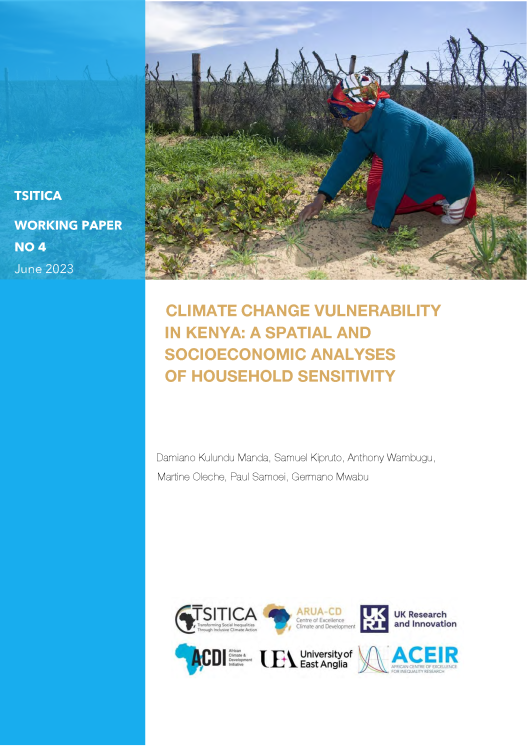Climate change vulnerability in Kenya: A spatial and socioeconomic analysis of household sensitivity
Damiano K. Manda, Samuel Kipruto, Anthony Wambugu, Martine Oleche, Paul Samoei, Germano Mwabu
TSITICA Project Working Paper no. 4, June 2023.

This paper presents spatial and socioeconomic analyses of climate change vulnerability of households in Kenya. The paper first examines trends in climate change vulnerability indicators in the period 2005 to 2019 using the 2005/2006 and 2015/2016 Kenya Integrated Household Budget Surveys (KIHBS) and the 2019 Kenya Population and Housing Census. Secondly, the paper constructs climate change vulnerability indices using the KIHBS 2015/2016 because that is the only survey containing all the required vulnerability indicators. Finally, that paper looks at a bivariate relationship between climate change hazards and household climate change vulnerability. A set of indicators of a household’s climate change sensitivity categorised as; housing living conditions, demographic structure, economic conditions, and nutrition are aggregated to generate two indices (an overall household climate change vulnerability index and a household climate change vulnerability intensity index). The spatial and social economic analysis of household climate change vulnerability is based on the two indices with the spatial analysis extended to counties - which are the sub-national units created by the Kenya Constitution in 2010 as the focal points for devolution. The results show that measures (indices) of climate change variability highlight heterogeneity in household climate change sensitivity across space (counties and location) and socio-economic characteristics. At the national level, 26.3% of households are vulnerable to climate change. Poor nutrition (food insecurity and child stunting) is the main contributor to vulnerability while economic activities (substance, pastoralism and open-air activities (‘jua kali’)) contribute the least. The results also, show that: overall, rural households are more vulnerable than urban households, poor households are more vulnerable than non-poor ones, female-headed households are more vulnerable than their male counterparts, wealthier households are less vulnerable than those with less asset wealth, and climate change sensitivity appears to decrease with the level of education attainment of the household head. Furthermore, there are remarkable differences in climate change sensitivities across counties. Finally, there is a strong spatial correlation between climate change shocks and household climate change sensitivities at the county level. The analysis highlights the need for policies and interventions to help counties adapt to climate change shocks. Read more
TSITICA was a collaborative, multi-country interdisciplinary research project. It brought together two ARUA Centres of Excellence with researchers from the universities of Ghana, Nairobi and Cape Town, and from the UK universities of Bristol, East Anglia and Manchester and the London School of Economics. The support of the African Research Universities Alliance and UK Research and Innovation are gratefully acknowledged. Visit project website.
